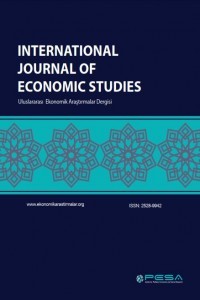Türkiye’de Arge Harcamaları, İhracat ve Büyüme Arasındaki İlişki: 1996-2016
Bu çalışmada Türkiye’nin 1996 – 2016 yılları arasında Ar-Ge harcamaları, İhracat ve GSYH serileri arasındaki ilişki çoklu doğrusal regresyon analizi ile incelenmiştir. Sonuç olarak, Ar-Ge harcamalarının ihracat üzerinde pozitif etkisinin olduğu, ihracatın da büyüme üzerinde pozitif etkisinin olduğu ortaya çıkmıştır. Ar-Ge harcamaları ile GSYH arasında ise doğrudan bir ilişki bulunamamıştır.
Anahtar Kelimeler:
Ar-Ge, İhracat, Büyüme, EKK Yöntemi, Regresyon Analizi
Relationship Between R&D Expenditures, Export and Growth in Turkey: 1996- 2016
In this study, the relationship examined between R&D expenditure, export and GDP for Turkey analysing with multiple linear regression analysis by using annual data for the 1996 – 2016 period. As a result, R&D expenditures have a positive effect on export and exports are also positively impacting on growth. There was no direct relationship between R & D expenditures and GDP
Keywords:
R & D, Export, Growth, OLS Method, Regression Analysis,
___
- Aghion Phillippe, Howitt Peter, (1989). “A Model of Growth through Creative Destruction”, Department of Economics Research Reports, 8904, 1989, London.
- Arrow, J. Kenneth (1962). “The Economic Implications of Learning by Doing”, The Review of Economic Studies, Vol: 29, No: 3, ss.155-173.
- Blackburn, Keith, Victor T. Y. Hung, Alberto F. Pozzolo, (2000). “Research, Development and Human Accumulation.”, Journal of Macroeconomics, Vol: 22, No: 2, p.189-206.
- Blanco, Luisa, James Prieger, (2013). “The Impact of Research and Develeopment on Economic Growth and Productivity in the US States.”, Pepperdin University, School of Public Policy, Working Papers 48.
- Braunerhjelm, Pontus, Per Thulin, 2006). “Can Countries Create Comparative Advantages?”, Centre of Excellence for Studies in Science and Innovation (CESIS) Electronic Working Paper Series, Paper No.61.
- Fraimane Rita, Signa Balina, (2016). “Research and Development Expenditures and Economic Growth in the EU: A Panel Data Analysis”, Economics and Business, Volume: 29, Issue: 1, s.5-11.
- Franstzen, Dirk, (2000). “R&D and Human Capital and International Technology Spillovers: A Cross Country Analysis.”, The Scandinavian Journal of Economics, 102(1), p.57-75.
- Goschin Zizi, (2014). “R&D as an Engine of Regional Economic Growth in Romania”, Romanian Journal of Regional Science, Vol: 8, No: 1, s.24-37.
- Göçer, İsmet, (2013). “Ar-Ge Harcamalarının Yüksek Teknolojili Ürün İhracatı, Dış Ticaret Dengesi ve Ekonomik Büyüme Üzerindeki Etkisi”, Maliye Dergisi, Sayı: 165, s.215- 240.
- Gülmez, Ahmet, (2009). “Endojen Büyüme Teorileri Kapsamında Türkiye ve Güney Kore’de Ekonomik Büyümenin Karşılaştırmalı Analizi”, Sakarya Üniversitesi Sosyal Bilimler Enstitüsü, Doktora Tezi.
- Grossman Gene M., Elhanan Helpman, (1991). “Innovation and Growth in the Global Economy”, MIT Press, Cambridge.
- Hall Bronwyn H., Mairesse Jacques, (1995). “Exploring the Relationship between R&D and Productivity in French Manufacturing Firms”, Journal of Econometrics, (65), ss.263- 293.
- Inekwe, John Nkwoma, (2015). “The Contribution of R&D Expenditure to Economic Growth in Developing Economies”, Social Indicators Research, Volume: 124, Issue: 3, s.727- 745.
- Khan, Jangraiz, (2015). “The Role of Research and Development in Economic Growth: A Review”, Journal of Economics Bibliography, Vol: 2, Issue: 3, p.128-133.
- Kılıç, Cüneyt, Yılmaz Bayar, Halil Özekicioğlu, (2014). “Araştırma Geliştirme Harcamalarının Yüksek Teknoloji Ürün İhracatı Üzerindeki Etkisi G-8 Ülkeleri İçin Bir Panel Veri Analizi,” Erciyes Üniversitesi İktisadi ve İdari Bilimler Fakültesi Dergisi, Sayı: 44, ss.115-130.
- Korkmaz Suna, (2010). “Türkiye’de Ar-Ge Yatırımları ve Ekonomik Büyüme Arasındaki İlişkinin VAR Modeli İle Analizi.”, Journal of Yasar University, 20(5), s. 3320-3330.
- Liik Margo, Jaan Masso, Kadri Ukrainski, (2014). “The Contribution of R&D to Production Effiency in OECD Countries: Econometric Analysis of Industry Level Panel Data”, Baltic Journal of Economics, Volume: 14, Issue: 1-2, 78-100.
- Martin Marek, (2015). “Effectiveness of Business Innovation and R&D in Emerging Economies: The Evidence from Panel Data Analysis”, Journal of Economics, Business and Management, Vol: 3, No: 4, s.440-446.
- Özer Mustafa, Necati Çiftçi, (2009). “Ar-Ge Tabanlı İçsel Büyüme Modelleri ve Ar-Ge Harcamalarının Ekonomik Büyüme Üzerine Etkisi: OECD Ülkeleri Panel Veri Analizi”, Sosyal Ekonomik Araştırmalar Dergisi, 1(16), s.219-240.
- Rivera-Batiz Luis A., M. Paul ROMER, , (1991). “International Trade with Endogenous Tecnological Change”, NBER Working Paper Series, No: 3594.
- Romer, M. Paul (1986), “Increasing Retuns and Long-Run Growth”, The Journal of Political Economy, Vol: 91, No: 5, s.1002-1037.
- Romer M. Paul (1990). “Endogeneus Technological Change”, The Journal of Political Economy, Vol: 98, No: 5, s.71-102.
- Schumpeter, Joseph Alois, (1978). “The Theory of Economic Development”, Oxford University Press, New York.
- Şahin Erdil B., (2015). “The Relationship Between R&D Expenditures and Economic Growth: Panel Data Analysis 1990-2013”, EY International Congress on Economics II, “Growth Inequality and Poverty”, November 5-6 2015, Ankara.
- Tarı, Recep, (2012). Ekonometri, Kocaeli Üniversitesi: Umuttepe Yayınları.
- Türedi, Salih, (2016). “The Relationship Between R&D Expenditures, Patent Applications and Growth: A Dynamic Panel Causality Analysis for OECD Countries”, Anadolu Üniversitesi Sosyal Bilimler Dergisi, Cilt: 16, No: 1, s.39-48.
- Wang Huachun, Dingchang Wu, (2015). “An Explanation for China’s Economic Growth: Expenditure on R&D Promotes Economic Growth”, Journal of Service Science and Management, (8), s.809-816.
- Yanyun Zhao, Mingqian Zhang, (2004). “R&D and Economic Growth”, In: Seoul Conference on Korea and the World Economy III, Seoul, Korea.
- Yardımcı Pınar, (2006). “İçsel Büyüme ve Türkiye’de İçsel Büyümeyi Etkileyen Faktörlerin Ampirik Analizi”, Selçuk Üniversitesi Sosyal Bilimler Enstitüsü İktisat Anabilim Dalı, Doktora Tezi.
- ISSN: 2528-9942
- Başlangıç: 2015
- Yayıncı: Politik Ekonomik ve Sosyal Araştırmalar Merkezi
Sayıdaki Diğer Makaleler
Üniversite Öğrencilerinin Geri Dönüşüm Bilinci Üzerine Bir Araştırma: Sakarya Üniversitesi Örneği
Katılım Bankaları İle Mevduat Bankalarının Çok Kriterli Karar Verme Yöntemi İle Karşılaştırılması
Endüstriyel İşletmelerde Enerji Verimliliği ve Enerji Yönetimi
Kriz Sonrası Bankacılık Sektörünün Yeniden Yapılandırılmasının Reel Etkileri: Türkiye Örneği
Fatih Cemil ÖZBUĞDAY, Önder ÖZGÜR
Türkiye’de Arge Harcamaları, İhracat ve Büyüme Arasındaki İlişki: 1996-2016
